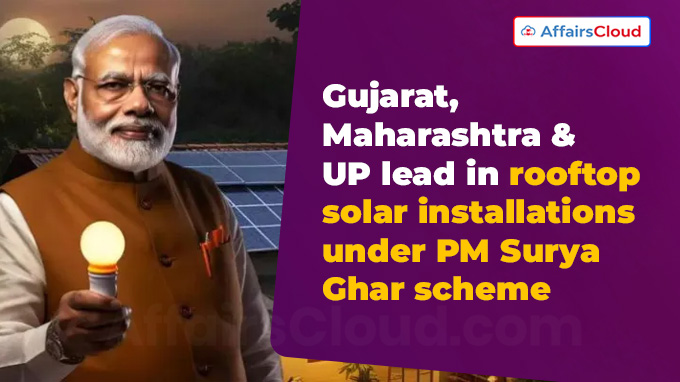 According to the Ministry of New and Renewable Energy (MNRE) data released in December 2024, Gujarat, Maharashtra and Uttar Pradesh (UP) are the top 3 states with the highest number of rooftop solar installations under ‘Prime Minister -Surya Ghar: Muft Bijli Yojana(PMSGMBY)’.
According to the Ministry of New and Renewable Energy (MNRE) data released in December 2024, Gujarat, Maharashtra and Uttar Pradesh (UP) are the top 3 states with the highest number of rooftop solar installations under ‘Prime Minister -Surya Ghar: Muft Bijli Yojana(PMSGMBY)’.
- As per the data, Gujarat has topped among all states in the country with 2,86,545 rooftop solar installations, followed by Maharashtra (with 1,26,344 installations) and UP (with 53,423 installations) ranked at 2nd and 3rd spot, respectively.
Key Points:
i.As of December 9, 2024, more than 6.79 lakh installations (total households covered) have been completed since the launch of scheme in February 2024.
- These include over 5.38 lakh individual residential units and around 1.41 lakh households through installations in residential welfare associations.
ii.So far, total 1.45 crore registrations and 26.38 lakh applications have been registered on the National Portal of the scheme and also subsidies have been disbursed to 3.66 lakh applicants.
iii.The data showed that 6 states: Gujarat, Maharashtra, UP, Kerala (with over 56,000 installations), Tamil Nadu (TN) (with over 21,000 installations), and Rajasthan (with over 20,000), collectively account for about 88% of the total rooftop solar installations to date.
About PM-Surya Ghar: Muft Bijli Yojana:
i.The Union Cabinet chaired by Prime Minister (PM) Narendra Modi approved the PM-Surya Ghar: Muft Bijli Yojana on 29th February, 2024.
- The Government of India (GoI) has allocated Rs 75,021 crore for the scheme and is to be implemented till Financial Year 2026-27 (FY27).
ii.This scheme is considered as the world’s largest domestic rooftop solar programme, which aims to provide free electricity of 300 units per month to 1 crore households in India by March 2027.
- The rooftop solar installations will be implemented in a phased manner, expected to cross 10 lakh by March 2025, 20 lakh by October 2025, and reach 40 lakh by March 2026.
iii.The scheme is being implemented by the National Programme Implementation Agency (NPIA) at the national level and by State Implementation Agencies (SIAs) at the state level, which also include power Distribution Companies (DISCOMs) or power/energy departments, depending on the State or Union Territory (UT).
iv.The scheme offers households a subsidy of up to 40% to install solar panels on roofs.
v.It also facilitates access to collateral-free, low-interest loans at around 7% interest for the installation of Residential rooftop Solar (RTS) system up to 3 kiloWatt (kW) capacity.
- The scheme offers a Central Financial Assistance (CFA) in the form of subsidy i.e. 60% subsidy for solar rooftop systems up to 2kW capacity.
- It offers a CFA of 40% for solar rooftop systems between 2kW to 3kW capacity.
- The CFA is capped for systems with a maximum capacity of 3 kW.
Significance:
i.The scheme is expected to generate additional 30 GigaWatt (GW) of solar capacity through residential rooftop installations.
ii.The scheme which aims to cover 1 crore households, will further help the Government to save Rs 75,000 crore annually in electricity costs.
iii.The scheme is expected to generate 1,000 billion units of electricity and reduce Carbon Dioxide (CO2) emissions by 720 million tonnes.
About Ministry of New & Renewable Energy (MNRE):
Union Minister- Pralhad Joshi (Constituency- Dharward, Karnataka)
Minister of State (MoS)- Shripad Yesso Naik (Constituency- North Goa, Goa)




